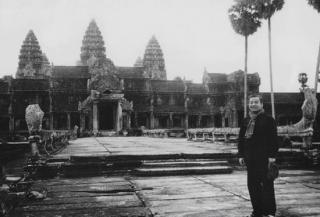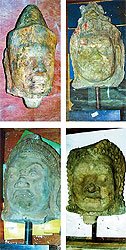You cannot be serious
From the archive: Problem prince in uneasy alliance with Pol Pot
12 October 1975: the symbolic head of state tells our correspondent, William Shawcross, of life in 'year zero' of the Khmer Rouge regime.
Prince Sihanouk talked in the presence of a Khmer Rouge companion. He was sitting beneath a picture of himself accepting an AK-47 automatic rifle – the universal symbol of revolution – from the Khmer Rouge. Since returning to Phnom Penh he has lived with his wife Monique in one of their old houses: “Food is brought to us every morning by the food service of the army. I have three little revolutionary cooks working for me and my aunt is teaching them cuisine. I sleep in the bed I once had made for my hero General de Gaulle. As I am very small, I am very comfortable. I just tell you this little detail for lady readers.” Last month the Khmer Rouge agreed to let him back to Phnom Penh only after lengthy negotiations with his Chinese hosts and sponsors. Sihanouk was in Moscow in March 1970 when Marshal Lon Nol took over in a coup and he spent the next five years living in Peking.
He is something of a problem for Cambodia’s new communist rulers. His popularity in the countryside might be unsettling for them and he did once sentence them to death and secretly allow President Nixon to bomb the communist camps. His talk gave some of the first clues about conditions in Phnom Penh since the Khmer Rouge marched into this city of 3m and emptied it of people. “The Khmer Rouge had to move them out because there was no meat, vegetables or rice,” he explains. “They had to be taken to the provinces the Khmer Rouge had liberated, where there was food for them.” The dangers of epidemics and starvation on the forced march into the countryside he does not describe, but he believes Phnom Penh is now adjusting to its new reality.
Sihanouk confesses to an admiration for the speed with which the Khmer Rouge have radicalised the country and their plans for the capital: “Phnom Penh was a Sodom and Gomorrah under Lon Nol. Now it is spartan. No nightclubs, no bars, no taxi girls. Much calmer than before. There are no cars. Everyone walks on foot. We are creating a new society with one class, not one where some people die of overeating and others die of hunger.” Asked if Cambodia, like North Vietnam, would demand US aid as reparations, he shouts: “We will never do so. Our blood is not to be commercialised. The US will have to pay for its crimes in the pages of history.”
“Before 1970 the free world used to call Sihanouk a dictator,” he says. “Now they are quite surprised. They don’t understand my role. Well, I’m like the Queen of England. I inspect schools and will receive ambassadors, etc, etc. That keeps me quite busy, you know. The ministers come and see me to ask my advice and give reports on their work.” He was allowed to make one brief visit to the countryside. Asked about massacres, he says: “I was not there, but I do not think so. Fighting exists only in the minds of some ugly Cambodians in Thailand and Paris. They fight from their nightclubs.” He still speaks, as when he was what he now calls “a playboy prince”, with wit, charm and enthusiasm that is often passion. Through his revolutionary ardour, loyally learnt in five courageous years in exile, the old jazz-playing film buff Sihanouk sometimes glitters a little sadly. Infuriated by a question about the fate of Lon Nol’s former cabinet ministers, he shouts again: “Why do you worry about these scum when so many good Cambodians have died? It’s not as if they were Marilyn Monroe or Rock Hudson.”
The impression Sihanouk conveys of his life in Phnom Penh, as the Khmer Rouge leaders wonder what to do with their old enemy, is a lonely one. A sad-eyed discontinued prince rattling around an empty palace in a scarred and empty capital. But he is extraordinarily resilient and persuasive and hopes his loyal, passionate nationalism alone may in time persuade his hosts that he can be used more effectively. He wants to work for them so long as they need him: “I think they need me now. But I have told them that if the day comes when they no longer do so, I’ll be very happy to be quite free and live in my little house in France. I like the movies, you know. I shall be able to go to the movies.”
Prince Sihanouk was deposed six months after this interview [but remained in Phnom Penh until a day before the Vietnamese forces overran the city]. Pol Pot’s genocidal regime led to the death of more than 20% of Cambodia’s population. Sihanouk, now 86, returned as king in 1993 until his abdication in 2004. Copyright 2009 Times Newspapers Ltd.Labels: Norodom Sihanouk



